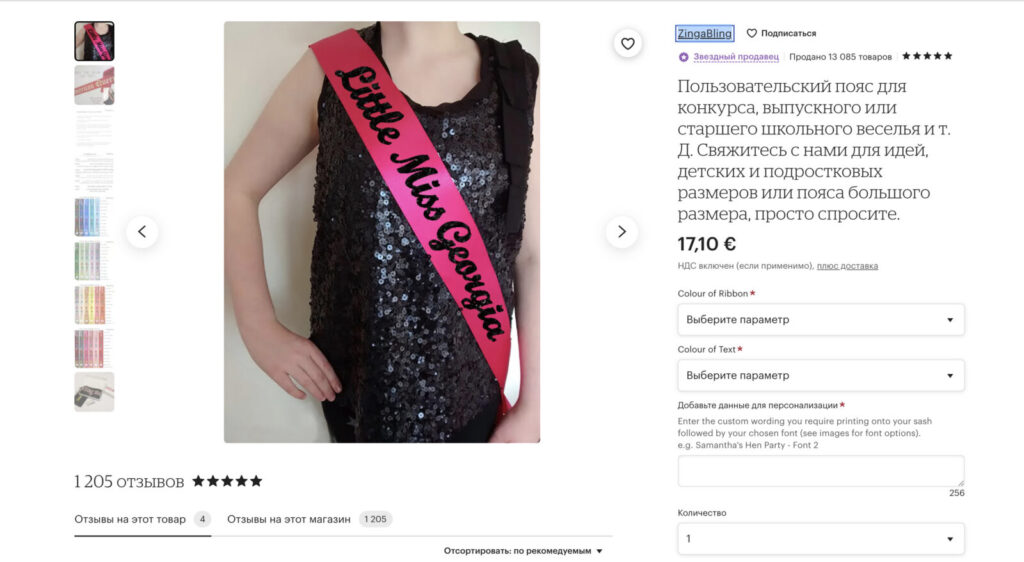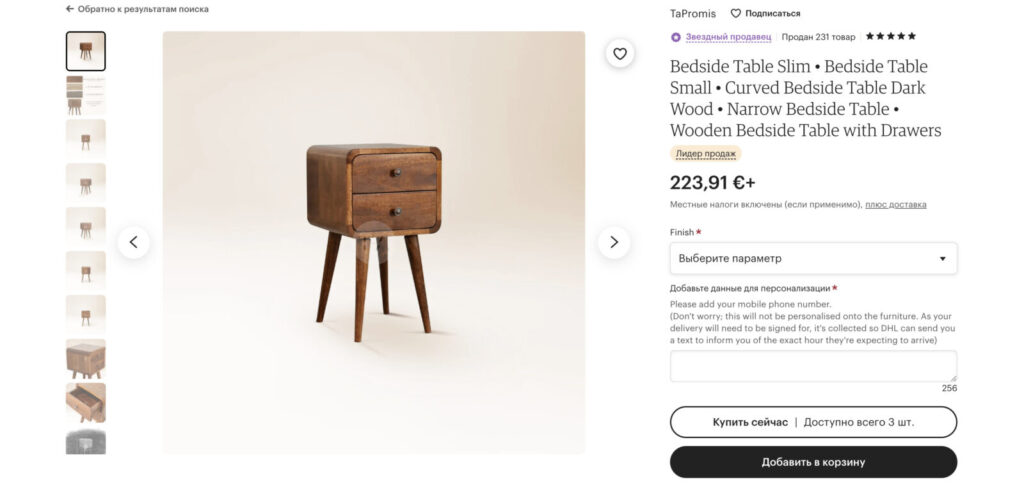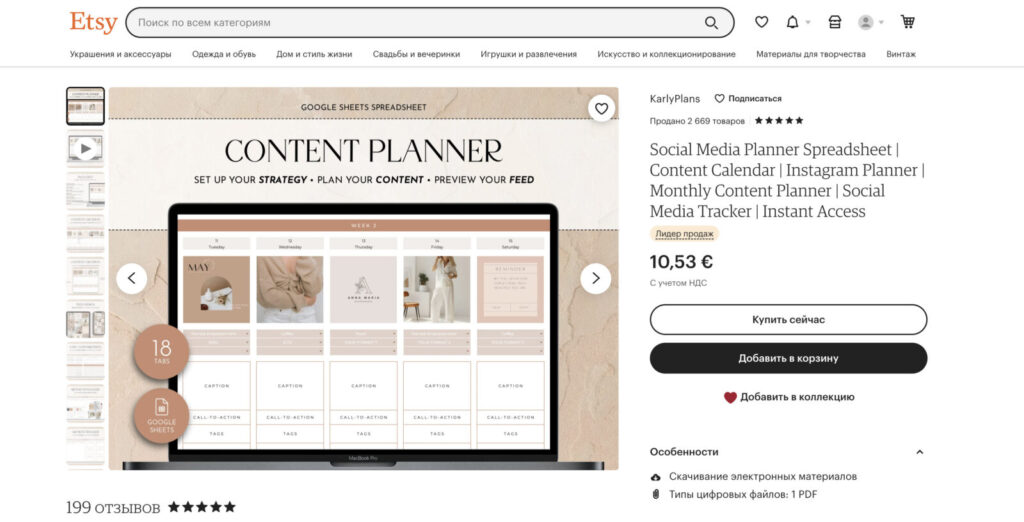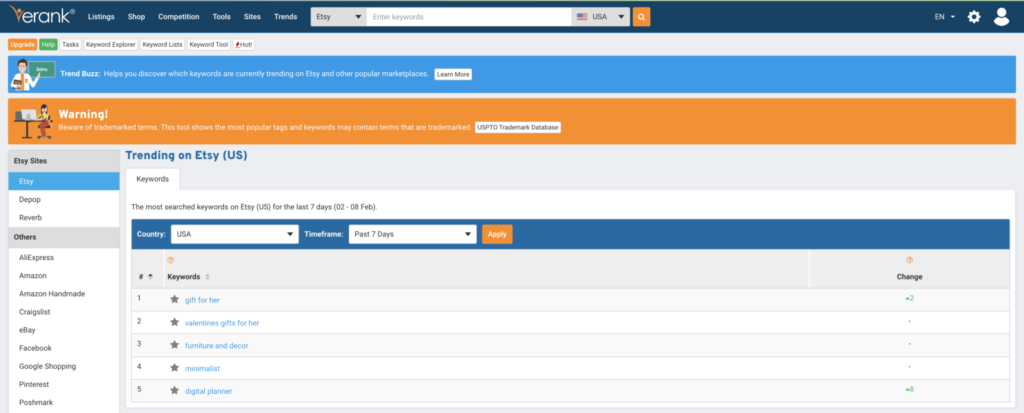“Millions of buyers and billions of dollars”
Etsy promises sellers. Such loud statements could be harshly criticised if it were not for the truly shocking statistics of Etsy shops.
A simple example: this seller offers customised inscriptions on satin ribbons.

Take a look at the number of reviews: at least 1205 people bought this product for €17.10, which is more than €20,000 in profit from one item. Not to mention the total number of sales (over 13 thousand items)!
Of course, the figures are quite superficial: they do not take into account taxes, expenses, commissions, Etsy shipping, and cost. But even without miscalculation of the cost side and deep business analytics, it is clear that the seller has a very good advantage.
It is not surprising that the marketplace quickly became a cult site, gaining recognition and popularity in all corners of the globe.
Etsy is a marketplace for creative entrepreneurs, art, antiques and handmade goods. You can sell any product that you have been directly involved in the development or creation of. It does not have to be Handmade in its purest form.
For example, if you are the owner of a sewing production facility and offer clothes based on the patterns of hired craftsmen, it is considered to be creative. Or you create drawings of bedside tables that are later made for you by a third-party carpentry shop.

This category of sellers is called “makers” – that is, the creators of any physical products.
In addition to makers, Etsy is actively used by designers: some create templates for printing, others create books, illustrations, paintings, diagrams, i.e. any design objects. At the same time, you can sell both the art itself (in digital form) and a physical product that you did not make, but which has your layout on it.

The main condition set by the Etsy marketplace is that you must not infringe on anyone’s intellectual property.
The rules strictly prohibit dropshipping and resale of mass-produced commercial products (but this prohibition does not apply to the category of “Creative Goods”).
At the same time, it is interesting that you can buy beads and clasps from China, put it all in boxes and present it to customers as a “Bracelet Making Kit”
As for vintage and antique goods, they must be manufactured at least 20 years ago.
The platform’s trends are highly susceptible to seasonality, calendar holidays and various hype events. That is, literally today, toys with the hero of a new Netflix film may be at the peak of popularity, and tomorrow, weight loss diaries from Pinterest may be at the peak of popularity.
In 2022, Etsy Ukraine-made is in the top of the list: souvenirs, flags, handicrafts and children’s drawings with national symbols that occupy the entire homepage.
However, the site does not have an internal analytics system, so you will need to use third-party services to search for relevant requests. We recommend Erank (to see the top positions within the platform) and marmalead.com (to find popular queries in specific categories).

However, even such statistics will not provide an in-depth understanding of what to do and whether there is demand in a particular niche. Rather, it will just give you ideas. You can use the free Google Trends website with no less success.
Practical experience and success stories show that the following categories of goods are the best-selling on Etsy:
Registering as an Etsy user takes just a few minutes. Everything is standard: name, phone number, email address. Then you can go to your seller account with just one click.

Take your time at this stage. First, we recommend that you read the internal manual. It really contains a lot of useful practical articles: from recommendations on choosing a name for your store to a guide on advertising.
Creating a store is really the “fun part”. This is where the main problems and major mistakes begin. For example, if you want to sell to the EU and the US, but choose Russian as the language of product description, you are already doing something wrong.
P.S: Unfortunately, there is no Ukrainian among the available languages.

If you are in Ukraine, the first surprise for you will be the “Choose a payment method” block (but we’ll talk about that below). If you don’t have any problems with the details, get ready to be surprised at the stage of creating product cards (spoiler alert: they are paid).
Like any other marketplace, Etsy wants to make as much money as possible from sellers. So be prepared to pay a lot of taxes and fees:
You can find a detailed list of all deductions here.
“But what about Etsy shipping?” a novice entrepreneur might ask. The answer is that it doesn’t exist. Unlike Amazon, Etsy doesn’t take on the responsibility of storing, packing, and shipping your goods. Be prepared to handle the logistics yourself.
And now to the “fly in the ointment” or the fact that “there is nothing more permanent than temporary”. In April 2021, the platform’s management began to actively promote its own system for accepting and withdrawing payments. Against this background, a “temporary” ban on the registration of new participants from countries that are not on the “privileged” list was introduced. As you might guess, this ban is still in effect.
It is worth noting here that Etsy Payments is tied to PayPal. Accordingly, you can open a store from those countries where this payment system operates (with special conditions for India, Turkey, and Israel).
In 2022, the news that PayPal had opened the possibility of receiving payments for Ukrainians made a big splash in the business community and handmade makers: everyone was excited about new commercial opportunities.
But, as it turned out later, we were given a chance to accept only personal payments (from family and friends, as it is written on the official website). PayPal is still not suitable for doing business. Simply put: you cannot connect your PayPal account to your Etsy store = you are not allowed to work on the marketplace.
Therefore, the seller faces 3 important questions:
There are not many options available:
1. Register from a foreign country that participates in the programme. Just in case, we publish a list of such countries below.

This is a logical option, but not an easy one. You will be asked to provide not only your residential address, but also an up-to-date bank account (which is very difficult for non-residents to open, especially without a personal visit).
2. Register a store with the help of relatives or friends who live in the EU or the USA.
Several problems arise here. From the obvious: not everyone has proxies in foreign countries. To the trivial: people’s reluctance to take on such responsibility (after all, in the event of a tax incident, the person who owns the store pays the taxes).
3. Buy a ready-made Etsy account with a connected payment system.
It is a rather risky way. And it’s not just about possible fraud. On one of the “good days”, the platform may ask you for identification, which you, of course, will not provide, because the account is registered to a stranger. In this way, you can lose not only your balance, but also the entire business in which you have invested a lot of effort.

However, there are plenty of offers with such a scheme on the Internet market. If you ever search for “How to register on Etsy” on Google, you won’t be able to get rid of contextual advertising on this topic for a long time.
4. Use the services of intermediaries
There are 2 options: when the store is opened FOR you (which is almost identical to method #3 and has the same risks) and the opening service FOR you.

We, in turn, offer a comprehensive “white” option (i.e. setting up a store on Etsy in accordance with the rules of the platform and international trade regulations). We help:
We also advise on the taxation of the chosen jurisdiction, i.e. we accompany you from the first sales to scaling.
More information is available in the services section. Or contact us for a free consultation to discuss your success plan.